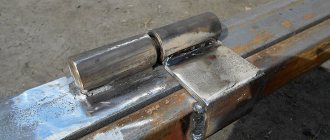Interior decoration is one of the most important tasks when working on a project, since it is what first appears before the customer’s eyes. Of course, you can do everything using proven methods that have already proven their effectiveness, and the costs for them will be much less, both financially and in terms of work time. However, modern technologies make it possible to introduce innovative mechanisms into the decoration of a room, which in practice increase safety and prove to be much more effective than standard solutions. One of these mechanisms is hidden hinges for interior, armored, metal doors.
The technology behind hidden hinges is actually not that complicated. However, the main problem of such a mechanism is the more labor-intensive installation and high demands on the door leaf. But before we talk about the advantages and disadvantages of hidden hinges, it is necessary to understand their features and understand how they differ from ordinary ones.
Correct marking
Installing door hinges by eye is unacceptable - even a small error can lead to distortion and deformation of the door leaf and structure. Marking is done with a pencil as follows:
- Attach the hinges to the intended installation locations. Hinges should be placed with a minimum distance of 20 centimeters from the edges of the door (top and bottom).
- Trace the hinges attached to the door end with a pencil, then set them aside.
- Using a chisel and hammer, make the indentations in the marked areas necessary to install the mortise hinges.
General view of the cutout for the door hinge
Pay close attention to the thickness of the recess. If it exceeds the thickness of the hinge, the door will rest against the frame when closing. Ultimately, this will lead to deformation of the door leaf and problems with opening and closing the door.
Before installing hinges on the door, you need to mark the door frame. This operation will require skill and patience to correctly determine the location of the loop:
- Place the canvas in the box and secure it with wooden wedges in the way it should be in the installed state. To level the door leaf, use a building level.
- After aligning the canvas, mark on the frame where the door hinges come into contact with the door.
- As with the door leaf, use a hammer and chisel to make the required number of recesses for installing door hinges.
The alignment of the door leaf in the frame should be carried out not only vertically, but also horizontally. Incorrect vertical installation will cause the door to open spontaneously, and horizontal installation will make it difficult to close.
A hinge already embedded in the doorway
Dimensions and drawings
The parameters of the safe are determined by the needs of its user. If there is no box with the specified dimensions on sale, you can make it according to your own drawings. When developing them, it is worth taking into account the regulations prescribed by law.
Safes used to store firearms and ammunition must be made of metal 2-3 mm thick. When storing cartridges, the minimum wall thickness is 3 mm. These parameters are reflected in the drawing.
Height, width and length are values determined by the dimensions of the object, which is the largest among those that will be inside. A limited supply is added to them to ensure the convenience of removing or placing the item in the safe.
A common safe used in everyday life is a small cache of compact dimensions. Fewer materials will be used for its production, which will reduce material costs.
It can easily be placed in a closet or other location suitable for installing a security box.
How to make a hatch in the basement
Almost all private houses have their own basement or cellar. If the entrance to it is in the floor, then you will need to make a floor hatch into the basement.
How to make such a hatch largely depends on the structural features of the lift and its location. Creating a basement hatch with your own hands involves making drawings, selecting and purchasing materials from which the structure will be created. The basement hatch, first of all, must be completely safe and convenient to use.
Features of the hatch device
A basement has many benefits, including acting as storage space and allowing the ground floor floor to retain heat better. The main disadvantage is the high cost of creating a basement, so most home owners make an opening in the floor and install a floor hatch in the basement with their own hands.
Installing hinges for a basement hatch
If your house or garage has a basement, the entrance to it must be blocked for safety reasons and also to prevent cold air from entering the room. The easiest way is to close the entrance with a hinged hatch.
It can be constructed from clapboard or steel sheets and, if necessary, insulated. You can also attach hinges for a floor hatch in the basement with your own hands. There are several types of loops, from which you need to choose the most suitable design. To do this, you need to consider how to make hinges for a basement hatch.
Hinge options
Depending on the frequency of use of the hatch and the amount of money that the owner is willing to spend on this design, you can choose from the following options:
- Overhead loops. This is the simplest mechanism. One part of it is attached to the door, and the other to the floor or wall from the inside. If desired, the shape of the hatch and hinges can be made unusual by adding forged or antique-decorated elements, thanks to which the structure will become an interior decoration.
- Secret loops. In this case, hidden hatch hinges are installed in the floor. If the door is made of the same material as the floor, the entrance to the basement will be completely invisible. You can even cover it with a carpet to prevent drafts from entering through the cracks. Then only the owners of the house will know about the existence of the door to the basement.
- Electric hinges. They are equipped with an electric motor that allows you to open access to the basement without effort. This option is well suited for heavy hatches made of steel or other materials that are difficult to lift manually. Such structures are either pulled out using a retractable hatch mechanism or folded back.
- Hinges with gas closers. Another way to make lifting the lid easier. In this case, it will be enough to apply a little force for the hatch to open on its own.
- Pantograph loops. When using such mechanisms, the door first moves upward and then moves to the side. In this case, it is convenient to use two doors so that they can be moved apart.
Points to consider
When installing hinges for the cellar lid, it is advisable to pay attention to the following points:
- Quality of connections. The hinges will bear the entire weight of the hatch cover structure, so they must be of high quality and strong enough. You can find cheap options on sale that can only withstand the weight of a small chipboard door. They are not suitable for heavy oak or steel hatches. The handle for lifting the door must also be able to withstand its weight with a reserve.
- Hatch dimensions. If the lid is large enough, two hinges may not be enough.
- Lack of wedge. The mechanism must be adjusted in such a way that the cellar door does not jam during regular use. To do this, it is necessary to maintain a small gap between the moving parts.
- Door strength. When actively using doors made of chipboard or wood, a large load is created on the edges. They can be strengthened with a metal corner.
- Possibility of service. Periodically, the mechanism requires lubrication. If shock absorbers are installed, they may need to be repaired or replaced. Therefore, when installing basement doors, it is necessary to maintain free access for their maintenance from above or from the underground.
Installing hinges
To install the hatch hinges, you need to complete the following steps:
- Determine the side where the basement lid will open and select the appropriate mechanism.
- Mark the installation locations with a pencil or chalk.
- Prepare the surface. If the lid is wooden, you can skip this step, since it should be immediately screwed on with self-tapping screws. If the hatch is a metal structure, holes for fastening must be made in advance.
- Install the door by placing a strip under its end, the thickness of which will be equal to the required gap between the door and the floor.
- The mechanism must be opened 90°, applied to the intended places and secured with self-tapping screws or self-tapping screws.
- The structure of the basement hatch in the floor needs to be adjusted. This requires slowly opening and closing the door several times, finding the positions where it begins to jam. After this, adjust the fastenings so as to remove the wedge. If this cannot be achieved by tightening the fasteners, the hinges will have to be removed and reinstalled.
It is recommended to lubricate the loops once every six months with lithol or sewing machine oil. If the door is in active use, more frequent cleaning may be necessary as lubricant tends to be produced. To perform such maintenance, most mechanisms have special technical holes.
Source: https://ZakromaDoma.ru/stroitelstvo/vubor-petley-dlya-lyuka-v-podval.html
What tools are needed for the job?
In order not to be distracted by extraneous factors during the work process, it is recommended to immediately prepare the necessary tools, equipment and materials presented below:
- Pencil for marking.
- Ruler or construction tape.
- Screwdriver and set of screws.
- Drill and cutter.
- Building level.
- Hammer and chisel.
After you have prepared all the specified tools and placed them in the work area, you can begin.











